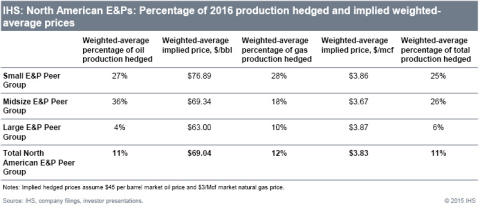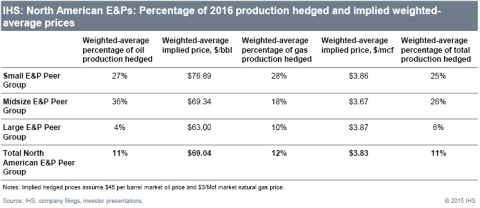HOUSTON--(BUSINESS WIRE)--Oil and gas hedging protections for North American exploration and production (E&P) companies will plunge in 2016 to just 11 percent of total production volumes, leaving many E&P companies at high risk of financial stress, according to new energy company performance analysis from IHS (NYSE: IHS), the leading global source of critical information and insight.
The IHS Energy North American E&P Peer Group Analysis: Hedging Protection Set to Plunge in 2016 assessed the amount of oil and gas hedging protections in place for 48 small, midsized and large North American E&P companies for the second-half of 2015 and full year 2016. Overall hedging for second-half 2015 was largely unchanged from the previous IHS analysis offered earlier this year--the North American E&Ps have 28 percent of total production hedged for the remainder of 2015.
The weighted-average hedged prices the group has in place for 2016 are $69.04 per barrel of oil and $3.83 per thousand cubic feet (MCF) of gas. The small and mid-sized E&Ps increased 2016 hedging the most during the first-half of 2015, while the large E&Ps remained mostly unhedged.
“The North American E&Ps remain largely exposed to low prices in 2016, with just 11 percent of their total production hedged for the year, at hedged prices significantly below those locked in for 2015,” said Paul O’Donnell, principal equity analyst at IHS Energy and author of the report. “For the smaller companies, the combination of less hedging and lower oil prices does not paint a pretty picture for 2016. Companies that missed the opportunity to lock in relatively higher oil prices during the second quarter of 2015 will face pressure to curtail drilling activity and CAPEX in order to avoid further balance sheet deterioration.”
O’Donnell said IHS expects capital spending for the North American E&P group will drop 25 percent in the second-half 2015, as compared with the first-half of 2015, from approximately $60 billion to $45 billion. The small North American E&Ps have hedged 25 percent of estimated 2016 total production and continue to have the weakest balance sheets, noted the IHS report. With high debt and little hedging, EXCO Resources and Comstock Resources are at risk of serious liquidity issues if low prices prevail.
The midsize E&Ps have hedged 26 percent of estimated 2016 total production. High-debt companies with low hedge protection in 2016 include SandRidge Energy and Ultra Petroleum, which are among the most at risk of additional financial stress. Pioneer Resources is well-hedged in 2016 and has lower debt than its peers. This has granted the company greater flexibility in its future spending plans and the company now expects to ramp-up drilling activity to its pre-oil price crash levels.
“The large North American E&Ps have hedged just six percent of 2016 production and will rely more on their stronger balance sheets to weather the low prices,” O’Donnell said. No oil-weighted large E&Ps have any significant hedging in place for 2016.”
The sector is busy cutting costs, and IHS believes that companies can now earn a similar rate of return at $60 per barrel that they used to be able to generate at $90 per barrel. “The rebound in oil prices during the second quarter created a window of opportunity for operators to lock in 2016 oil volumes at stronger prices,” O’Donnell said.
High-debt companies, including Halcón Resources, Penn Virginia, Bill Barrett and Whiting Petroleum added the most oil hedging for 2016, taking advantage of the relative higher prices during second quarter 2015, said the IHS report. The recent drop in oil futures prices suggests that operators will be unable to lock in new hedging volumes at attractive prices. Futures prices for West Texas Intermediate (WTI) oil, as of 29 September 2015, do not currently reach $60 per barrel between now and 2020.
“Those that missed these comparatively higher prices in the second quarter will likely be exposed to market prices next year, while those companies that layered in additional hedging appear to have made the correct choice,” O’Donnell said.
To speak with Paul O’Donnell, please contact Melissa Manning at melissa.manning@ihs.com. For more information on subscribing to the IHS Energy Company and Transaction Research, please contact sales.energy@ihs.com
About IHS (www.ihs.com)
IHS (NYSE: IHS) is the leading source of insight, analytics and expertise in critical areas that shape today’s business landscape. Businesses and governments in more than 150 countries around the globe rely on the comprehensive content, expert independent analysis and flexible delivery methods of IHS to make high-impact decisions and develop strategies with speed and confidence. IHS has been in business since 1959 and became a publicly traded company on the New York Stock Exchange in 2005. Headquartered in Englewood, Colorado, USA, IHS is committed to sustainable, profitable growth and employs about 8,800 people in 32 countries around the world.
IHS is a registered trademark of IHS Inc. All other company and product names may be trademarks of their respective owners. © 2015 IHS Inc. All rights reserved.




